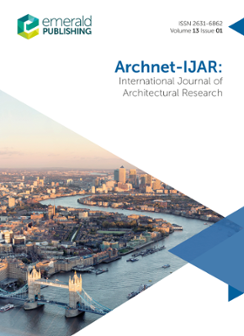Archnet-IJAR: Volume 16 Issue 1
Strapline:
International Journal of Architectural ResearchTable of contents
Knowledge spaces in architecture and urbanism – a preliminary five-year chronicle
Ashraf M. SalamaCommemorating the 15th year anniversary of discourse, knowledge dissemination in architecture and urbanism through the contributions published in Archnet-IJAR: International…
The use of an analytic hierarchy process to evaluate the flexibility and adaptability in architecture
Sabine De Paris, Carlos Nuno Lacerda Lopes, Alvaro Neuenfeldt JuniorInvestigation of housing adaptability is related to understanding factors that influence project transformation. Factors may be associated with the design and project stage as…
The child as an active participant: enhancing the child's attachment to kindergartens through architectural design
Dalia A. Beheiry, Hisham S. GabrRecently, children are no longer considered the passive users of their spaces; they are rather treated as active participants in those spaces design, with their own experiences…
The effects of environmental factors on the social interaction of children in need of protection in outdoor living spaces
Ecem Kara, Dilek Yildiz OzkanSocial interaction has a vital role in the healthy development of children. Growing up without a family for children – who are called “children in need of protection” (CNP) in…
Mapping and measuring spatial connectivity of the pathways to home-based businesses within informal urban contexts
Ha Minh Hai Thai, Quentin Stevens, Judy RogersThis paper presents a mixed methodology to map and analyse the spatial connectivity of the everyday pathways that link the doorway of an individual's home–work locations to the…
Engaging in social interaction: relationships between the accessibility of path structure and intensity of passive social interaction in urban parks
Faezeh Mohammadi Tahroodi, Norsidah UjangFunctioning as space connectors, path structures in urban parks may rarely present social interaction opportunities, although centralized activity spaces are available. This paper…
A sustainability assessment framework for population density in central Indian cities
Tanushri Kamble, Sarika Pankaj BahadureThe urban population in Indian cities is increasing at an alarming speed. Accommodating such a huge population while sustaining the environment is a challenge in urban areas…
The reestablishment of Mosul's city fabric: an approach to computational hybridization
Mostafa Alani, Akel Ismail KaheraThis paper aims out to analyze the confluence of spatial analysis and computational design strategies to support the reestablishment of Mosul's city housing fabric. According to a…
COVID-19 and “the trinity of boredom” in public spaces: urban form, social distancing and digital transformation
Hisham Abusaada, Abeer ElshaterOver the coming decades, the widespread application of social distancing creates challenges for the urban planning and design profession. This article aims to address the…
A blended learning strategy: reimagining the post-Covid-19 architectural education
Naglaa Megahed, Asmaa HassanThe present work reviews the impacts of the Covid-19 pandemic on architecture education (AE), with the aim of discussing the interaction and integration of technology-based models.
Exploring sketches as conceptual data: a semiological experiment on moods visualisation among architectural students
Mohd Shahrudin Abd Manan, Blakely KennedySketching is a creative skill that most architects develop over their long period of study and is considered an effective medium for communicating imaginative thinking and…

ISSN:
2631-6862Online date, start – end:
2019Copyright Holder:
Emerald Publishing LimitedOpen Access:
hybridEditor:
- Professor Ashraf Salama